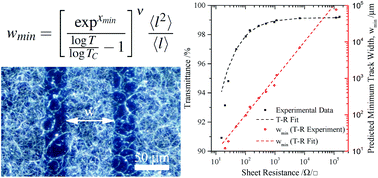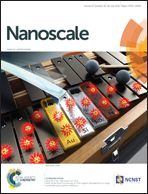Finite-size scaling in silver nanowire films: design considerations for practical devices†
Abstract
We report the first application of finite-size scaling theory to nanostructured percolating networks, using silver nanowire (AgNW) films as a model system for experiment and simulation. AgNWs have been shown to be a prime candidate for replacing Indium Tin Oxide (ITO) in applications such as capacitive touch sensing. While their performance as large area films is well-studied, the production of working devices involves patterning of the films to produce isolated electrode structures, which exhibit finite-size scaling when these features are sufficiently small. We demonstrate a generalised method for understanding this behaviour in practical rod percolation systems, such as AgNW films, and study the effect of systematic variation of the length distribution of the percolating material. We derive a design rule for the minimum viable feature size in a device pattern, relating it to parameters which can be derived from a transmittance–sheet resistance data series for the material in question. This understanding has direct implications for the industrial adoption of silver nanowire electrodes in applications where small features are required including single-layer capacitive touch sensors, LCD and OLED display panels.



 Please wait while we load your content...
Please wait while we load your content...